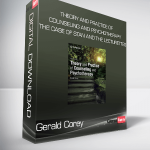-63%
Gerald Corey – Theory and Practice of Counseling and Psychotherapy – The Case of Stan and the Lecturettes
Original price was: $92.00.$34.00Current price is: $34.00.
Incorporating the thinking, feeling and behaving dimensions of human experience…
- Description
- Reviews (0)
Description
Gerald Corey – Theory and Practice of Counseling and Psychotherapy – The Case of Stan and the Lecturettes

Incorporating the thinking, feeling and behaving dimensions of human experience, the Eleventh Edition of Corey’s best-selling text helps readers compare and contrast the therapeutic models expressed in counseling theories.
Table of Contents
- COVER PAGE
- TITLE PAGE
- COPYRIGHT PAGE
- DEDICATION
- ABOUT THE AUTHOR
- PREFACE TO ELEVENTH EDITION
- ACKNOWLEDGMENTS
- PART 1. BASIC ISSUES IN COUNSELING PRACTICE
- Chapter 1. Introduction and Overview
- Where I Stand
- Suggestions for Using the Book
- Overview of the Theory Chapters
- Introduction to the Case of Stan
- Intake Interview with Stan
- Overview of Some Key Themes in Stan’s Life
- Background on the Case of Gwen
- Intake Session
- Video on Counseling Sessions with Gwen
- Overview of Video MindTap Program for The Case of Gwen
- Chapter 1 Intake Session
- Chapter 2 Multicultural Perspectives
- Chapter 3 Informed Consent Session
- Chapter 4 Psychoanalytic (Psychodynamic) Therapy
- Chapter 5 Adlerian Therapy
- Chapter 6 Existential Therapy
- Chapter 7 Person-Centered Therapy
- Chapter 8 Gestalt Therapy
- Chapter 9 Behavior Therapy
- Chapter 10 Cognitive Behavior Therapy
- Chapter 11 Choice Theory/Reality Therapy
- Chapter 12 Feminist Therapy/Social Justice
- Chapter 13 Postmodern Approaches: Solution-Focused Brief Therapy
- Chapter 14 Family Systems Therapy
- Chapter 15 Integrative Approaches
- Chapter 2. The Counselor: Person and Professional
- The Counselor as a Therapeutic Person
- Personal Characteristics of Effective Counselors
- Personal Therapy for the Counselor
- The Counselor’s Values and the Therapeutic Process
- The Role of Values in Counseling
- Can Counselors Who Self-Identify as Religious Provide Value-Free Counseling to LGBTQ+ Clients?
- Addressing Religious and Spiritual Values in Counseling
- The Role of Values in Developing Therapeutic Goals
- Becoming an Effective Multicultural Counselor
- Acquiring Competencies in Multicultural Counseling
- Incorporating Culture in Counseling Practice
- Issues Faced by Beginning Therapists
- Dealing With Anxiety
- Being Yourself and Self-Disclosure
- Avoiding Perfectionism
- Being Honest About Your Limitations
- Understanding Silence
- Dealing with Demands From Clients
- Dealing with Clients Who Lack Commitment
- Tolerating Ambiguity
- Becoming Aware of Your Countertransference
- Developing a Sense of Humor
- Sharing Responsibility with the Client
- Declining to Give Advice
- Defining Your Role as a Counselor
- Maintaining Your Vitality as a Person and as a Professional
- Summary
- Self-Reflection and Discussion Questions
- Recommended Supplementary Readings for Chapter 2
- References
- The Counselor as a Therapeutic Person
- Chapter 3. Ethical Issues in Counseling Practice
- Putting Clients’ Needs Before Your Own
- Ethical Decision Making
- The Role of Ethics Codes as a Catalyst for Improving Practice
- Some Steps in Making Ethical Decisions
- The Right of Informed Consent
- Dimensions of Confidentiality
- Ethical Concerns with the Use of Technology
- Exceptions to Confidentiality and Privileged Communication
- Ethical Issues From a Multicultural Perspective
- Are Current Theories Adequate in Working With Culturally Diverse Populations?
- Is Counseling Culture-Bound?
- Focusing on Both Individual and Environmental Factors
- Ethical Issues in the Assessment Process
- The Role of Assessment and Diagnosis in Counseling
- Ethical Aspects of Evidence-Based Practice
- Managing Multiple Relationships in Counseling Practice
- Perspectives on Multiple Relationships
- Becoming an Ethical Counselor
- Summary
- Self-Reflection and Discussion Questions
- Where to Go From Here
- Recommended Supplementary Readings for Chapter 3
- References
- Chapter 1. Introduction and Overview
- PART 2. THEORIES AND TECHNIQUES OF COUNSELING
- Chapter 4. Psychoanalytic Therapy
- Key Concepts
- View of Human Nature
- Structure of Personality
- Consciousness and the Unconscious
- Anxiety
- Ego-Defense Mechanisms
- Development of Personality
- The Therapeutic Process
- Therapeutic Goals
- Therapist’s Function and Role
- Client’s Experience in Therapy
- Relationship Between Therapist and Client
- Application: Therapeutic Techniques and Procedures
- Maintaining the Analytic Framework
- Free Association
- Interpretation
- Dream Analysis
- Analysis and Interpretation of Resistance
- Analysis and Interpretation of Transference
- Application to Group Counseling
- Applying the Psychoanalytic Approach to School Counseling
- Jung’s Perspective on the Development of Personality
- Contemporary Trends: Object-Relations Theory, Self Psychology, and Relational Psychoanalysis
- Summary of Stages of Development
- Some Directions of Contemporary Psychodynamic Therapy
- An Expert’s Perspective on Psychoanalytic Therapy
- Discussion Questions Related to Dr. Blau’s Psychoanalytic Perspective
- Psychoanalytic Therapy From a Multicultural Perspective
- Strengths From a Diversity Perspective
- Shortcomings From a Diversity Perspective
- Summary and Evaluation
- Summary
- Contributions of the Classical Psychoanalytic Approach
- Contributions of Contemporary Psychoanalytic Approaches
- Limitations and Criticisms of Psychoanalytic Approaches
- Self-Reflection and Discussion Questions
- Where to Go From Here
- Recommended Supplementary Readings for Chapter 4
- References
- Key Concepts
- Chapter 5. Adlerian Therapy
- Key Concepts
- View of Human Nature
- Goal-Directed Movement
- Goal-Orientation and the Unity of the Personality
- Community Feeling and Social Interest
- Private Logic
- Life Tasks
- Influences on Individual Development
- Birth Order and Sibling Relationships
- Culture, Race, and Ethnicity: Systemic Holism
- The Therapeutic Process
- Therapeutic Goals
- Therapist’s Function and Role
- Client’s Experience in Therapy
- Relationship Between Therapist and Client
- Application: Therapeutic Techniques and Procedures
- Phase 1: Establishing the Relationship
- Phase 2: Assessing the Individual’s Psychological Dynamics
- Phase 4: Adaptive Reorientation and Reeducation
- Application for Individual Psychology
- Application for Family Counseling
- Application for Group Counseling
- Applying the Adlerian Approach to School Counseling
- An Expert’s Perspective on Adlerian Therapy
- Discussion Questions Related to Dr. Bitter’s Adlerian Perspective
- Adlerian Therapy From a Multicultural Perspective
- Strengths From a Diversity Perspective
- Shortcomings From a Diversity Perspective
- Summary and Evaluation
- Summary
- Contributions of the Adlerian Approach
- Limitations and Criticisms of the Adlerian Approach
- Self-Reflection and Discussion Questions
- Where to Go From Here
- Recommended Supplementary Readings for Chapter 5
- References
- Key Concepts
- Chapter 6. Existential Therapy
- Introduction
- Historical Background in Philosophy and Existentialism
- Key Figures in Contemporary Existential Psychotherapy
- Key Concepts
- View of Human Nature
- Proposition 1: The Capacity for Self-Awareness
- Proposition 2: Freedom and Responsibility
- Proposition 3: Striving for Identity and Relationship to Others
- Proposition 4: The Search for Meaning
- Proposition 5: Anxiety as a Condition of Living
- Proposition 6: Awareness of Death and Nonbeing
- The Therapeutic Process
- Therapeutic Goals
- Therapist’s Function and Role
- Client’s Experience in Therapy
- Relationship Between Therapist and Client
- Application: Therapeutic Techniques and Procedures
- Phases of Existential Counseling
- Clients Appropriate for Existential Counseling
- Application to Brief Therapy
- Application to Group Counseling
- Applications of Existential Approach to School Counseling
- An Expert’s Perspective on Existential Therapy
- Discussion Questions Related to Dr. Deurzen’s Existential Perspective
- Existential Therapy From a Multicultural Perspective
- Strengths From a Diversity Perspective
- Shortcomings From a Diversity Perspective
- Summary and Evaluation
- Summary
- Contributions of the Existential Approach
- Limitations and Criticisms of the Existential Approach
- Self-Reflection and Discussion Questions
- Where to Go From Here
- Recommended Supplementary Readings for Chapter 6
- References
- Introduction
- Chapter 7. Person-Centered Therapy
- Introduction
- Four Periods of Development of the Approach
- Emotion-Focused Therapy
- Existentialism and Humanism
- Abraham Maslow’s Contributions to Humanistic Psychology
- Key Concepts
- View of Human Nature
- The Therapeutic Process
- Therapeutic Goals
- Therapist’s Function and Role
- Client’s Experience in Therapy
- Relationship Between Therapist and Client
- Application: Therapeutic Techniques and Procedures
- Early Emphasis on Reflection of Feelings
- Evolution of Person-Centered Methods
- The Role of Assessment
- Application of the Philosophy of the Person-Centered Approach
- Application to Crisis Intervention
- Application to Group Counseling
- Application of the Person-Centered Approach with Children and Adolescents in School Counseling
- Person-Centered Expressive Arts Therapy
- Principles of Expressive Arts Therapy
- Creativity and Offering Stimulating Experiences
- An Expert’s Perspective on Person-Centered Expressive Arts
- Discussion Questions Related to the Person-Centered Expressive Arts Perspective
- Person-Centered Therapy From a Multicultural Perspective
- Strengths From a Diversity Perspective
- Shortcomings From a Diversity Perspective
- Summary and Evaluation
- Summary
- Contributions of the Person-Centered Approach
- Limitations and Criticisms of the Person-Centered Approach
- Self-Reflection and Discussion Questions
- Where to Go From Here
- Recommended Supplementary Readings for Chapter 7
- References
- Introduction
- Chapter 8. Gestalt Therapy
- Introduction
- Key Concepts
- View of Human Nature
- Some Principles of Gestalt Therapy Theory
- Contact and Resistances to Contact
- The Now
- Unfinished Business
- Energy and Blocks to Energy
- The Therapeutic Process
- Therapeutic Goals
- Therapist’s Function and Role
- Client’s Experience in Therapy
- Relationship Between Therapist and Client
- Application: Therapeutic Techniques and Procedures
- The Experiment in Gestalt Therapy
- Preparing Clients for Gestalt Experiments
- The Role of Confrontation
- Gestalt Therapy Interventions
- Application to Group Counseling
- Application of the Gestalt Approach to School Counseling
- An Expert’s Perspective on Gestalt Therapy
- Discussion Questions Related to the Gestalt Therapy Perspective
- Gestalt Therapy From a Multicultural Perspective
- Strengths From a Diversity Perspective
- Shortcomings From a Diversity Perspective
- Summary and Evaluation
- Summary
- Contributions of Gestalt Therapy
- Limitations and Criticisms of Gestalt Therapy
- Self-Reflection and Discussion Questions
- Where to Go From Here
- Recommended Supplementary Readings for Chapter 8
- References
- Chapter 9. Behavior Therapy : Coauthored by Caroline Bailey and Sherry Cormier
- Introduction
- Historical Background
- Four Areas of Development
- Key Concepts
- Current Trend in Behavior Therapy
- Basic Characteristics and Assumptions
- The Therapeutic Process
- Therapeutic Goals
- Therapist’s Function and Role
- Client’s Experience in Therapy
- Relationship Between Therapist and Client
- Application: Therapeutic Techniques and Procedures
- Applied Behavioral Analysis: Operant Conditioning Techniques
- Progressive Muscle Relaxation
- Systematic Desensitization
- In Vivo Exposure and Flooding
- Eye Movement Desensitization and Reprocessing
- Social Skills Training
- Self-Management Programs and Self-Directed Behavior
- Multimodal Therapy: Clinical Behavior Therapy
- Mindfulness and Acceptance-Based Approaches
- Application to Group Counseling
- Applying the Behavioral Approach to School Counseling
- An Expert’s Perspective on Behavior Therapy
- Discussion Questions Related to the Behavior Therapy Perspective
- Behavior Therapy From a Multicultural Perspective
- Strengths From a Diversity Perspective
- Shortcomings From a Diversity Perspective
- Summary and Evaluation
- Summary
- Contributions of Behavior Therapy
- Limitations and Criticisms of Behavior Therapy
- Self-Reflection and Discussion Questions
- Where to Go From Here
- Recommended Supplementary Readings for Chapter 9
- References
- Introduction
- Chapter 10. Cognitive Behavior Therapy
- Introduction
- Albert Ellis’s Rational Emotive Behavior Therapy
- Introduction
- Key Concepts
- View of Emotional Disturbance
- ABC Framework
- The Therapeutic Process
- Therapeutic Goals
- Therapist’s Function and Role
- Client’s Experience in Therapy
- Relationship Between Therapist and Client
- Application: Therapeutic Techniques and Procedures
- The Practice of Rational Emotive Behavior Therapy
- Applications of REBT as a Brief Therapy
- Application of REBT to Group Counseling
- Application of REBT to School Counseling
- An Expert’s Perspective on Rational Emotive Behavior Therapy
- Discussion Questions Related to the REBT Perspective
- Aaron Beck’s Cognitive Therapy
- Introduction
- A Generic Cognitive Model
- Basic Principles of Cognitive Therapy
- The Client–Therapist Relationship
- Applications of Cognitive Therapy
- Applying Cognitive-Behavioral Counseling with Adolescents in Schools
- Christine Padesky and Kathleen Mooney’s Strengths-Based Cognitive Behavior Therapy
- Introduction
- Basic Principles of Strengths-Based CBT
- The Client–Therapist Relationship
- Applications of Strengths-Based CBT
- An Expert’s Perspective on Cognitive Behavior Therapy
- Discussion Questions Related to Dr. Christine Padesky’s Cognitive Behavior Perspective
- Donald Meichenbaum’s Cognitive Behavior Modification
- Introduction
- How Behavior Changes
- Stress Inoculation Training
- A Cognitive Narrative Approach to Cognitive Behavior Therapy
- Cognitive Behavior Therapy From a Multicultural Perspective
- Strengths From a Diversity Perspective
- Shortcomings From a Diversity Perspective
- Summary and Evaluation
- Summary
- Contributions of the Cognitive-Behavioral Approaches
- Limitations and Criticisms of the Cognitive-Behavioral Approaches
- Self-Reflection and Discussion Questions
- Where to Go From Here
- Recommended Supplementary Readings for Chapter 10
- References
- Chapter 11. Choice Theory/Reality Therapy
- Introduction
- Key Concepts
- View of Human Nature
- Choice Theory Explanation of Behavior
- Characteristics of Reality Therapy
- The Therapeutic Process
- Therapeutic Goals
- Therapist’s Function and Role
- Client’s Experience in Therapy
- Relationship Between Therapist and Client
- Application: Therapeutic Techniques and Procedures
- The Practice of Reality Therapy
- The Counseling Environment
- Procedures That Lead to Change
- The “WDEP” System
- Application to Group Counseling
- Application of Reality Therapy to School Counseling
- An Expert’s Perspective on Choice Theory/Reality Therapy
- Discussion Questions Related to the Choice Theory/Reality Therapy Perspective
- Choice Theory/Reality Therapy From a Multicultural Perspective
- Strengths From a Diversity Perspective
- Shortcomings From a Diversity Perspective
- Summary and Evaluation
- Summary
- Contributions of Choice Theory/Reality Therapy
- Limitations and Criticisms of Choice Theory/Reality Therapy
- Self-Reflection and Discussion Questions
- Where to Go From Here
- Recommended Supplementary Readings for Chapter 11
- References
- Chapter 12. Feminist Therapy
- Introduction
- History and Development
- key Concepts
- Constructs of Feminist Theory
- Feminist Perspective on Personality Development
- Recent Trends in Feminist Therapy
- Principles of Feminist Therapy
- The Therapeutic Process
- Therapeutic Goals
- Therapist’s Function and Role
- Client’s Experience in Therapy
- Relationship Between Therapist and Client
- Application: Therapeutic Techniques and Procedures
- The Role of Assessment and Diagnosis
- Techniques and Strategies
- The Role of Men in Feminist Therapy
- Application of the Feminist Approach to Group Work
- Feminist Social Justice Principles Applied to School Counseling
- An Expert’s Perspective on Feminist Therapy
- Discussion Questions Related to the Feminist Therapy Perspective
- Feminist Therapy from a Multicultural and Social Justice Perspective
- Strengths From a Diversity Perspective
- Shortcomings From a Diversity Perspective
- Summary and Evaluation
- Summary
- Contributions of Feminist Therapy and Multicultural and Social Justice Perspectives
- Limitations and Criticisms of Feminist Counseling
- Self-Reflection and Discussion Questions
- Where to Go From Here
- Recommended Supplementary Readings for Chapter 12
- References
- Introduction
- Chapter 13. Postmodern Approaches
- Introduction to Social Constructionism
- Historical Glimpse of Social Constructionism
- The Collaborative Language Systems Approach
- Solution-Focused Brief Therapy
- Introduction
- Key Concepts
- The Therapeutic Process
- Applying SFBT to Group Counseling
- Application of Solution-Focused Counseling to School Counseling
- An Expert’s Perspective on Solution-Focused Brief Therapy
- Discussion Questions Related to the Solution-Focused Brief Therapy Perspective
- Motivational Interviewing
- The MI Spirit
- Common Ground with Person-Centered Therapy
- The Basic Principles of Motivational Interviewing
- The Stages of Change
- Common Ground with Solution-Focused Brief Therapy
- Application of Motivational Interviewing to School Counseling
- Narrative Therapy
- Introduction
- Key Concepts
- The Therapeutic Process
- Application: Therapeutic Techniques and Procedures
- Application of Narrative Therapy to Group Counseling
- An Expert’s Perspective on Narrative Therapy
- Discussion Questions Related to the Narrative Therapy Perspective
- Postmodern Approaches From a Multicultural Perspective
- Strengths From a Diversity Perspective
- Shortcomings From a Diversity Perspective
- Summary and Evaluation
- Summary
- Contributions of Postmodern Approaches
- Limitation and Criticisms of Postmodern Approaches
- Self-Reflection and Discussion Questions
- Where to Go From Here
- Recommended Supplementary Readings for Chapter 13
- References
- Introduction to Social Constructionism
- Chapter 14. Family Systems Therapy: Coauthored by James Robert Bitter and Gerald Corey
- Introduction
- The Family Systems Perspective
- Differences Between Systemic and Individual Approaches
- Development of Family Systems Therapy
- Structural-Strategic Family Therapy
- Recent Innovations in Family Therapy
- A Multilayered Process of Family Therapy
- Forming a Relationship
- Conducting an Assessment
- Hypothesizing and Sharing Meaning
- Facilitating Change
- Application of Family Systems Approaches to School Counseling
- An Expert’s Perspective on Family Systems Therapy
- Discussion Questions Related to the Family Systems Therapy Perspective
- Family Systems Therapy From a Multicultural Perspective
- Strengths From a Diversity Perspective
- Shortcomings From a Diversity Perspective
- Summary and Evaluation
- Summary
- Contributions of Family Systems Approaches
- Limitations and Criticisms of Family Systems Approaches
- Self-Reflection and Discussion Questions
- Where to Go From Here
- Recommended Supplementary Readings for Chapter 14
- References
- Introduction
- Chapter 4. Psychoanalytic Therapy
- PART 3. INTEGRATION AND APPLICATION
- Chapter 15. An Integrative Perspective
- The Movement Toward Psychotherapy Integration
- Pathways Toward Psychotherapy Integration
- Advantages of Psychotherapy Integration
- The Challenge of Developing an Integrative Perspective
- Integration of Multicultural Issues in Counseling
- Integration of Spirituality and Religion in Counseling
- The Therapeutic Process
- Therapeutic Goals
- Therapist’s Function and Role
- Client’s Experience in Therapy
- Relationship Between Therapist and Client
- The Place of Techniques and Evaluation in Counseling
- Drawing on Techniques From Various Approaches
- Evaluating the Effectiveness of Counseling and Therapy
- Feedback-Informed Treatment
- Summary
- Concluding Comments
- Self-Reflection and Discussion Questions
- Where to Go From Here
- Recommended Supplementary Readings for Chapter 15
- References
- The Movement Toward Psychotherapy Integration
- Chapter 15. An Integrative Perspective
- 16. CASE ILLUSTRATION: AN INTEGRATIVE APPROACH IN WORKING WITH STAN
- Counseling Stan: Integration of Therapies
- A Place to Begin
- Clarifying the Therapeutic Relationship
- Clarifying the Goals of Therapy
- Working with Stan’s Past, Present, and Future
- Identifying Feelings
- Expressing and Exploring Feelings
- The Thinking Dimension in Therapy
- Doing: Another Essential Component of Therapy
- Working Toward Revised Decisions
- Encouraging Stan to Work with His Family of Origin
- The Spiritual Dimension
- Working with Stan’s Drinking Problem
- Moving Toward Termination of Therapy
- Encouraging Stan to Join a Therapy Group
- Commentary on the Thinking, Feeling, and Doing Perspective
- Counseling Stan: Integration of Therapies
- 17. TRANSACTIONAL ANALYSIS
- Introduction
- Historical Background
- Key Concepts
- View of Human Nature
- The Ego States
- The Need for Strokes
- Injunctions and Counterinjunctions
- Decisions and Redecisions
- Games
- Basic Psychological Life Positions and Lifescripts
- The Therapeutic Process
- Therapeutic Goals
- Therapist’s Function and Role
- Client’s Experience in Therapy
- Relationship between Therapist and Client
- Application: Therapeutic Techniques and Procedures
- Therapeutic Procedures
- Application to Groups
- Applying Transactional Analysis in School Counseling
- Transactional Analysis from a Multicultural Perspective
- Contributions to Multicultural Counseling
- Limitations for Multicultural Counseling
- Summary and Evaluation
- Summary
- Contributions of Transactional Analysis
- Limitations and Criticisms of Transactional Analysis
- Experiential Exercises and Activities for Transactional Analysis
- Where to Go from Here
- Recommended Supplementary Readings
- References and Suggested Readings
- A Case Illustration: A Transactional Analyst’s Perspective on Ruth by John M. Dusay, M.D.
- Introduction
Get Digital Download ” Gerald Corey – Theory and Practice of Counseling and Psychotherapy – The Case of Stan and the Lecturettes ” Right Now!




Reviews
There are no reviews yet.